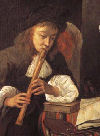Flute Recorder

The recorder is a woodwind musical instrument of the family known as fipple flutes or internal duct flutes — whistle-like instruments which include the tin whistle and ocarina. The recorder is end-blown and the mouth of the instrument is constricted by a wooden plug, known as a block or fipple. It is distinguished from other members of the family by having holes for seven fingers (the lower one or two often doubled to facilitate the production of semitones) and one for the thumb of the uppermost hand. The bore of the recorder is occasionally cylindrical but is usually tapered slightly, being widest at the mouthpiece end.
The recorder was popular from medieval times but declined in the eighteenth century in favour of orchestral woodwind instruments, such as the flute, oboe, and clarinet, which have greater chromatic and dynamic range. During its heyday, the recorder was traditionally associated with birds, shepherds, miraculous events, funerals, marriages and amorous scenes. Images of recorders can be found in literature and artwork associated with all these. Purcell, Bach, Telemann and Vivaldi used the recorder to suggest shepherds and birds, and the pattern continued into the 20th century.
The recorder was revived in the twentieth century, partly in the pursuit of historically informed performance of early music, but also because of its suitability as a simple instrument for teaching music and its appeal to amateur players. Today, it is often thought of as a child's instrument, but there are many excellent virtuosic players who can demonstrate the instrument's full potential as a solo instrument. The sound of the recorder is remarkably clear and sweet, partly because of the lack of upper harmonics and predominance of odd harmonics in the sound.
Flute notes
Recorder | © All Right Reserved - Tal Sharon
